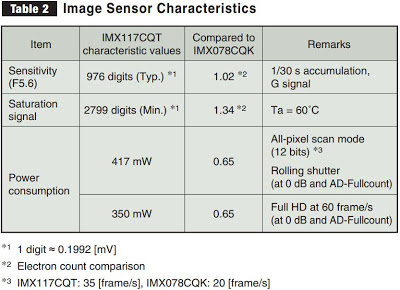The sensor is very fast delivering 35fps at full resolution at 430mW power. It also capable to 4K/60fps video (10b ADC mode) and includes HD-ish slow motion modes:
Another important announcement is the first stacked sensor product, the 1/4-inch 8MP 1.12um pixel ISX014, naturally, with integrated ISP:
 |
| Sony illustration of the stacked structure does not seem to have any wafer-to-wafer contacts in the pixel array area |
Not much information is given about the sensor. It supports 1940 x 1080p video at 30fps and 1280 x 720p video at 60fps. The built-in scalar function makes it possible to shrink all of the 8MP to perform 16:9 cropping for video. Power consumption is 270 mW in 8MP JPEG@15fps mode or 202 mW in 2MP YUV@30mode which are quite good numbers, possibly due to an advanced process node used for ISP die.
The image samples which were supposed to show the sensor's high quality, are of low resolution, unfortunately:
Another announcement is the new 1-inch 9.19MP CCDs: the ICX814ALG (B&W) and the ICX814AQG (color). The sensors have 4 outputs and multitude of readout modes, the fastest one being 1080p at 36fps:





Could some one enlighten me, from the pdf
ReplyDeleteimx117cqt shows sensitive as 976 digits and imx078cqk as 1437 digits, rest parameters are same as F5.6 1/30s G signal. and imx117 claimed more sensitive than imx078? Shouldn't it be more large the digits the better the sensitive?
Same goes for saturation signal too which is 2799 vs 3089 and sony claims 2799 is better
The hint is *2 Electron count comparison.
DeleteThis indicates that conversion gain is different.
no wafer to wafer contacts under the pixel array --> column level ADC? Are bump bonding contacts affecting the pixel performance?
ReplyDeleteYes. Exmor means column-level ADC.
DeleteOf course, bump degrades thermal and stress properties.
IR sensors have bumps under the pixel array. How do they deal with thermal/stress issues then?
Deleteshow me an IR sensor with a 1.12um pixel pitch and then we can talk about comparing the thermal stress issues.
DeleteSince it seems the hybrid device is only connected on the edges and not pixel by pixel, I dont think the pixel pitch counts. Furthermore, since hybrid IRFPAs are pixel-wise bump-bonded and cycle thru more extreme temperature ranges, I think for now an edge-bonded array is pretty easy to make reliable.
Delete